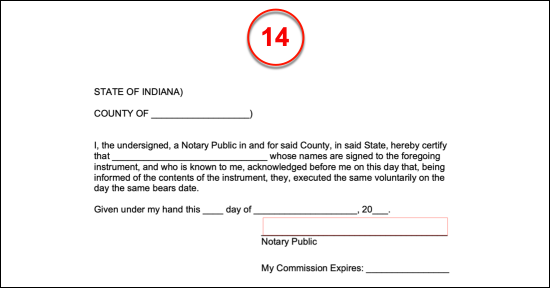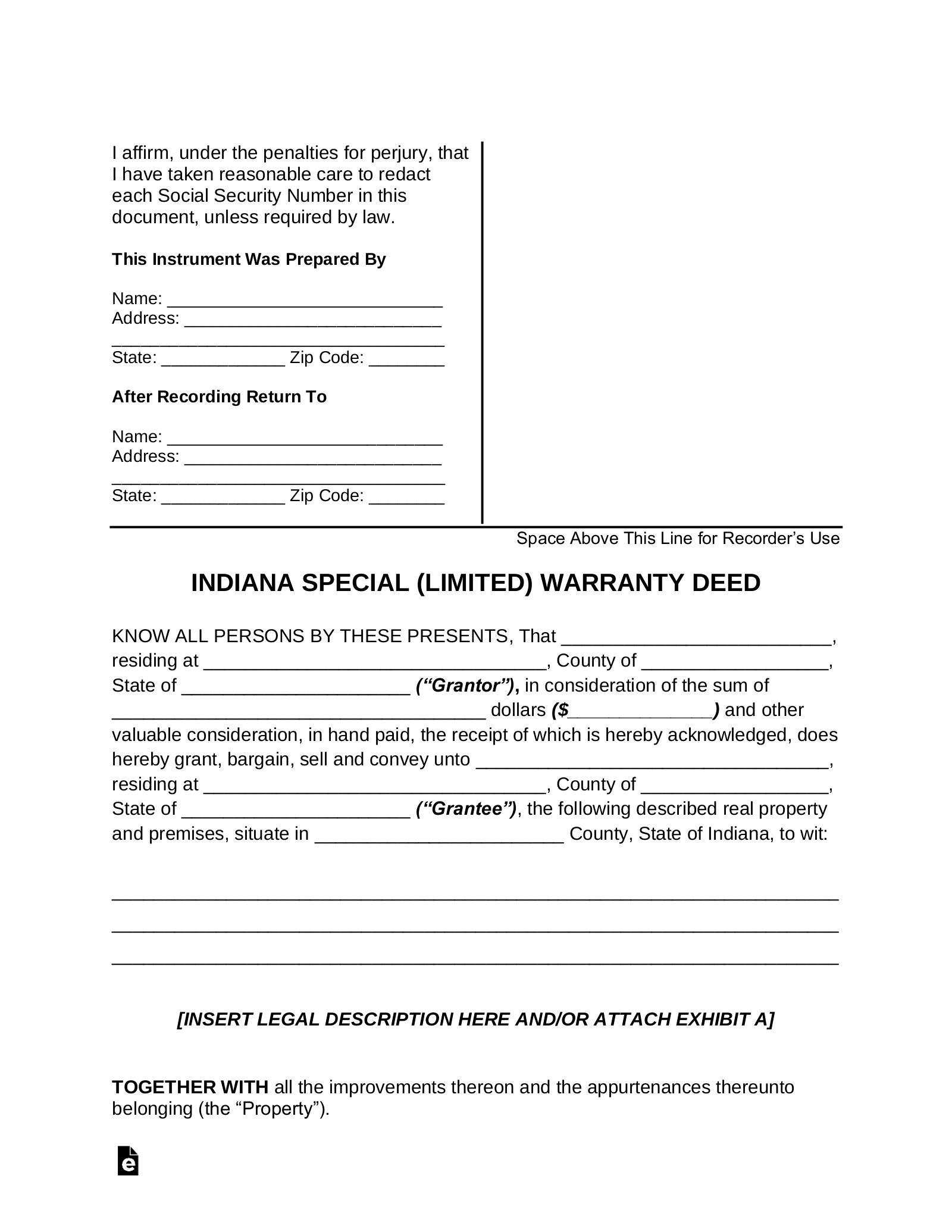Updated April 10, 2024
An Indiana special warranty deed is similar to a warranty deed in that it guarantees a seller has a title to sell to a buyer, though it only provides a limited guarantee. The guarantee is limited to the grantor’s ownership of the property and not any previous ownership. As with all cases of property transfer, it is vitally important that a thorough property search is conducted to determine whether the grantor has a clear title or whether there are other interests still tied to the property such as an undischarged mortgage or a hidden right of way.
Laws – Title 32 (Property), Article 21 – Conveyance Procedures for Real Property
Signing (IC § 32-21-2-3) – Must be acknowledged before a Notary Public.
Recording – This form may be filed at the County Recorder’s Office in the jurisdiction where the property is located.
How to Write
Download; PDF, MS Word, OpenDocument
I. Indiana Statment Preparer
(1) Reporter Name. Both the name and the legal mailing address of the Party obtained to deliver the definitions this paperwork requires is required at this document’s opening. Place this information where requested.

II. Indiana Recorder Instruction
(2) Clerical Directive. After this paperwork has been filed, the Indiana County Recorder will mail the physical document to the mailing address of the Recipient named in the second section. Generally, this will be the Indiana Real Property Grantee or one of his or her Representatives but may be any Party the Indiana Grantor and Grantee agree upon. Dispense this Recipient’s name and entire mailing address to the appropriate section once it has been verified as a well-monitored destination.

III. Indiana Real Property Grantor
(3) Identity Of Indiana Property Grantor. The name of the current Owner of the Indiana real property who has accepted payment in exchange for a signature transfer of ownership over the concerned Indiana Real Estate is the next requirement of this paperwork. Present the full name of the Indiana Grantor in the first statement. Keep in mind, that if there is more than one Indiana Property Grantor involved in this real estate, each one will need to be named here so that he or she can transfer ownership by signature. If not, then a separate statement will need to be developed for each one.
(4) Formal Home Address. The building number and the street, avenue, road etc. defining the Indiana Real Property Grantor (Seller/Owner) physical home address should be presented on the second line of this statement. Note, that if an apartment or unit number is needed to visit the Real Property Grantor (at home) then this must be included as part of the street address.
(5) Location Of Indiana Grantor Home. Continue with a report on the Indiana Grantor’s County and State associated with his or her street address.
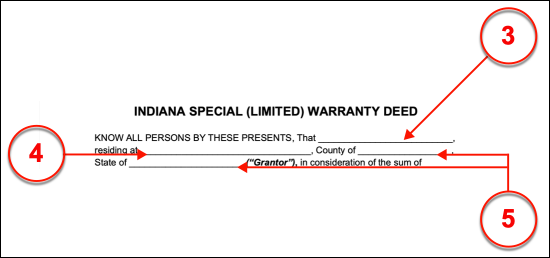
IV. Received Indiana Property Payment
(6) Payment Report. Since this document will transfer the current Indiana Property Owner’s real estate to the Grantee, the payment that was required for this action will need to be recorded. Write out the payment amount the Indiana Grantor received then use the parentheses area to present it numerically.

V. Indiana Real Property Grantee
(7) Grantee Assuming Indiana Property. Ownership of the Indiana property may only be transferred through this paperwork if the Grantee receiving is identified. Furnish the legal name of the Indiana Grantee as the Party who shall assume the Ievel of ownership the Grantor currently enjoys over the real property. If more than one Indiana Grantee should be set to take over ownership over the Indiana real estate, then each one must be identified in this statement.
(8) Home Address Of Indiana Grantee. In addition to the Indiana Grantee Name, each Grantee’s address must be included to the statement of conveyance being made. If more than one Indiana Grantee has been named earlier in this statement, then each one’s address must be documented. This statement requires the physical street address, County, and State of the Indiana Grantee’s residence supplied separately to the areas requesting them. Begin by presenting the Indiana Grantee’s street address.
(9) County And State Of Indiana Grantee. Conclude the discussion defining the Indiana Grantee with a record of the Grantee’s or Grantees’ residential County and the State.
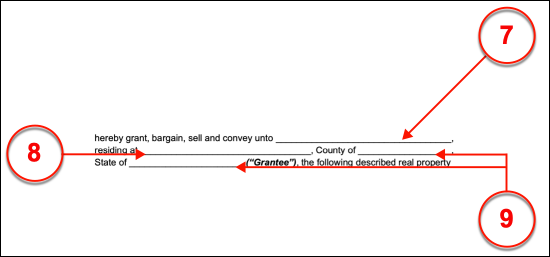
VI. Indiana Property
(10) Indiana Property County Of Location. The Indiana Grantor’s property to be conveyed must have the County where it is geographically found documented.
(11) Legal Description Of Indiana Property. Dispense the physical address of the property the Indiana Grantor is transferring to the Indiana Grantee as well as the legal description held by the Indiana County Recorder Office’s on that property. Note that this information may also be obtained from the most filed issued deed on this property.

Signature Of Indiana Grantor
(12) Effective Signature. This statement documents the Indiana Grantor’s official release of his or her current ownership over real estate or real property. Naturally, such an impactful statement must be provable. Every Indiana Grantor that has been named to carry this intent must sign his or her name.
(13) Indiana Grantor Information. Every Indiana Grantor effecting this conveyance by signature must submit the printed version of his or her name and present the address of his or her residence.
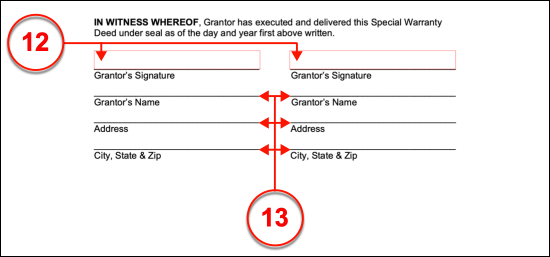
VII. Notarization Of Indiana Property Grantor
(14) Notary Verification. The delivery of the Indiana Grantor’s signature is required to occur under the direction of a licensed Notary Public. The notarization process engaged with this signature will be completed by the Notary who will also deliver proof of notarization through his or her statement and credentials in the final section.
